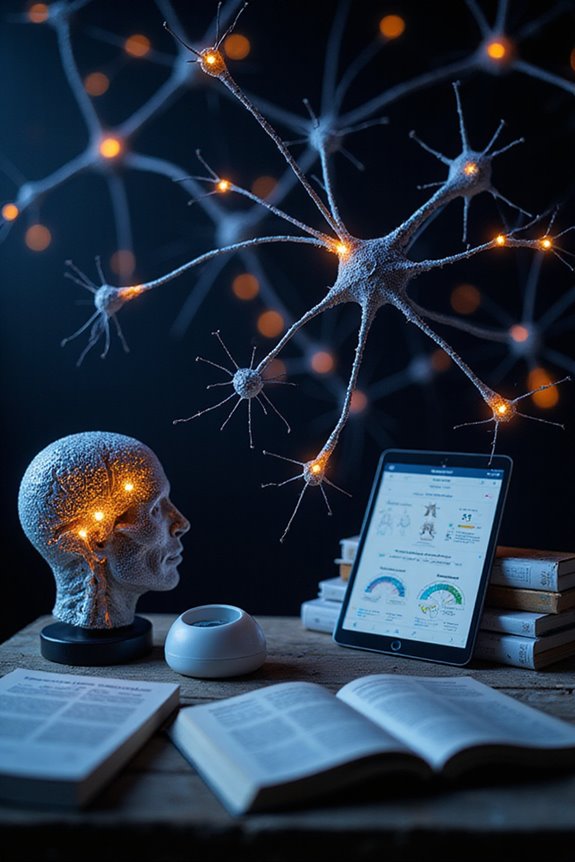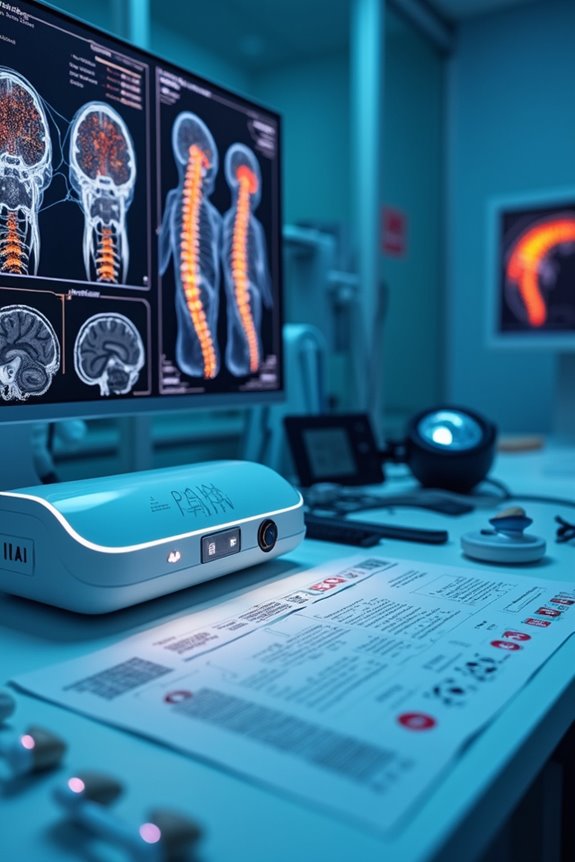Recent findings in pain neuroscience emphasize key developments:
- Interdisciplinary collaboration enhances understanding of pain mechanisms.
- Approximately 70% of chronic pain patients have histories of psychological trauma, affecting pain severity.
- Novel agents like VIP36 show potential for effective analgesia with reduced opioid side effects.
- Brain-computer interface technologies offer personalized pain management solutions.
These advancements signal a shift towards more thorough approaches in treatment. Further insights are available on the integration of novel therapies and their effects.
Key Takeaways
- Interdisciplinary collaborations enhance understanding of pain, integrating biology, neurology, and pharmacology for innovative pain management strategies.
- Advances in drug discovery, like VIP36, target specific pain pathways, offering longer-lasting relief with fewer opioid side effects.
- Emotional trauma significantly impacts chronic pain, with emotional processing therapies helping to alleviate pain severity.
- Brain-computer interfaces (BCIs) provide real-time feedback on pain perception, showing promise in personalized pain management approaches.
- Ongoing research focuses on genetic factors in pain perception and the development of evidence-based personalized medicine for improved patient outcomes.
Advances in Pain Neuroscience Research Platforms
Advances in Pain Neuroscience Research Platforms have greatly enhanced the understanding and treatment of pain disorders. These platforms promote interdisciplinary collaboration, allowing researchers from biology, neurology, and pharmacology to converge on pain-related challenges.
Key Features:
- Multinational Initiatives: Programs like ERA-NET NEURON 2025 focus on translational research projects.
- High-Throughput Screening: Infrastructure such as EU-OPENSCREEN enables rapid testing of compounds on pain-relevant biological models, accelerating drug discovery.
- Integration of Expertise: Collaborative efforts enhance the synergy between academic institutions and drug discovery networks.
The emphasis on bridging mechanistic insights with therapeutic applications supports the development of novel diagnostics and treatment options for chronic pain, fostering a cohesive environment for breakthrough research.
Emotional and Psychological Dimensions of Chronic Pain

Chronic pain is a complex condition that intertwines emotional and psychological factors, greatly influencing patient outcomes. Approximately 70% of chronic pain patients report histories of psychological trauma, often originating in childhood. This trauma correlates with pain severity, as it disrupts the integration of bodily sensations and emotional experiences.
Emotional responses such as anxiety, sadness, and anger can perpetuate pain, creating a feedback loop that exacerbates both emotional distress and pain perception. Clinical studies indicate that 30% to 45% of chronic pain patients experience clinical depression. Psychotherapeutic interventions, particularly Emotional Awareness and Expression Therapy, focus on emotional processing to transform traumatic emotions. By identifying and labeling feelings, patients can reduce limbic brain activity, alleviating pain and improving overall well-being.
Novel Treatments and Drug Development

Novel treatments and drug development in pain management are progressing rapidly, driven by innovative research and targeted approaches.
- VIP36 Development: NIH-funded researchers engineered VIP36, targeting specific pain pathways to treat both acute and chronic pain effectively while minimizing opioid side effects. Early preclinical results suggest longer-lasting analgesia compared to existing options.
- Neural Pathway Reconstruction: Stanford Medicine’s in vitro model utilizes stem cell-derived organoids to recreate sensory neural pathways. This method accelerates testing of new pain-relief compounds, enhancing understanding of chronic pain mechanisms.
- Targeted Neural Pathways: The discovery of a distinct neural pathway for chronic pain enables the development of targeted treatments, potentially reducing side effects and improving patient quality of life.
These advancements signify substantial drug innovation in pain management.
Brain-Computer Interface and Neurofeedback Therapies

Brain-computer interfaces (BCIs) and neurofeedback therapies represent a transformative approach in pain management, leveraging real-time feedback to help patients alter their pain perception. These non-invasive systems utilize EEG monitoring to track neural patterns associated with pain, enabling patients to voluntarily modify these patterns.
- Clinical studies indicate significant neurofeedback efficacy, demonstrating reductions in pain intensity among chronic pain populations.
- BCI applications target personalized treatment, focusing on individual-specific pain-related neural signatures.
- Challenges persist, including the need for optimized protocols for various pain types and validation of long-term efficacy through randomized controlled trials.
Advancements in this field highlight the potential of BCIs to revolutionize pain management strategies and improve patient outcomes.
Integration of Multidisciplinary Approaches in Pain Treatment

The integration of multidisciplinary approaches in pain treatment is reshaping the landscape of chronic pain management.
- Multidisciplinary collaboration involves diverse experts—physicians, physical therapists, and psychologists—working together to create tailored treatment plans.
- Integrated therapies, such as medication management, physical exercise, and cognitive behavioral therapy, address the multifaceted nature of chronic pain.
- Evidence supports that multimodal multidisciplinary approaches (MMAs) reduce pain severity and improve overall quality of life, as demonstrated by programs like PAINDOC.
- Patients experience enhanced mobility and decreased reliance on medications through coordinated efforts.
- Major health organizations endorse these models as best practices, highlighting their effectiveness in fostering psychological well-being and social engagement in chronic pain patients.
This thorough approach prioritizes patient-centered care and holistic healing.
Future Directions and Research Priorities
Future Directions and Research Priorities in pain neuroscience are increasingly shaped by advancements in technology and a deeper understanding of biological mechanisms.
- Research will focus on genetic factors and neuroinflammation mechanisms that influence pain modulation and chronic pain susceptibility.
- Machine learning applications will analyze large datasets for biomarkers identification, enhancing personalized strategies in treatment.
- Advanced neuroimaging techniques, such as high-field MRI and PET, will visualize pain networks and neurochemical changes in vivo.
- Collaboration across disciplines will facilitate the development of sophisticated pain models, accelerating translational research.
- Emphasis will be placed on refining pain phenotyping, integrating clinical and biological factors to tailor interventions effectively.
- Longitudinal studies will provide insights into pain trajectories, paving the way for improved chronic pain management.
The Role of Emotional Regulation in Chronic Pain Management
Emotional regulation plays a crucial role in the management of chronic pain, as it greatly influences both the perception and experience of pain. Therapeutic approaches targeting emotional dysregulation have shown promise in reducing pain intensity.
- Emotional resilience is enhanced through therapy that retrains the brain, focusing on both negative and positive emotional states.
- Patients report approximately a 10-point reduction in self-reported pain intensity, with improvements sustained for up to six months.
- Emotional regulation interventions also correlate with better mental health outcomes, including reduced anxiety and improved sleep quality.
- Randomized controlled trials emphasize the efficacy of digital delivery methods in reaching diverse populations, further supporting the accessibility of these essential therapies.
Promising Drug Candidates and Their Potential Impact
Recent advancements in pharmacotherapy are highlighting promising drug candidates that may greatly impact pain management.
- Cebranopadol: A potential first dual-NMR agonist, showed positive phase 3 trial results. It may reduce opioid side effects while effectively addressing nociceptive and neuropathic pain.
- Suzetrigine: FDA-approved for acute pain, targets the Nav1.8 sodium channel, offering a non-opioid alternative with ongoing trials to assess chronic pain efficacy.
- AP-325: Demonstrated significant reduction in post-surgical neuropathic pain, with additional benefits in sleep quality and mental health.
- VIP36: An innovative NIH-funded drug candidate, shows promise for treating both acute and chronic pain.
These drug candidates signify a shift toward safer and more effective options in pain management, reflecting critical advancements in pain neuroscience.
Frequently Asked Questions
How Does Chronic Pain Affect Daily Life and Relationships?
Chronic pain transforms vibrant lives into silent battlegrounds, where social isolation reigns. Emotional support fades, as relationships strain under burdens, leaving individuals yearning for connection amidst the shadows of pain, ultimately diminishing their sense of belonging.
What Are the Long-Term Effects of Chronic Pain on Mental Health?
Chronic pain can greatly diminish emotional resilience and contribute to cognitive decline, fostering feelings of hopelessness and anxiety. This prolonged struggle often isolates individuals, complicating their mental health and overall quality of life.
How Can Lifestyle Changes Impact Pain Management?
Lifestyle changes greatly impact pain management by incorporating mindfulness meditation and enhancing sleep hygiene. These practices foster community support, reduce stress, and promote overall well-being, ultimately helping individuals manage pain more effectively and improve their quality of life.
Are There Specific Diets That Help Alleviate Chronic Pain?
In the intricate tapestry of nutrition, anti-inflammatory diets and ketogenic benefits emerge, suggesting tailored dietary approaches may alleviate chronic pain. Emphasizing nutrient-rich foods, individuals find pathways to healing, strengthening their sense of community and well-being.
What Role Does Physical Activity Play in Pain Relief?
Physical activity plays an essential role in pain relief, as exercise benefits, particularly movement therapy, can reduce pain perception. Engaging in tailored exercise programs fosters a sense of community and belonging among individuals facing chronic pain challenges.





